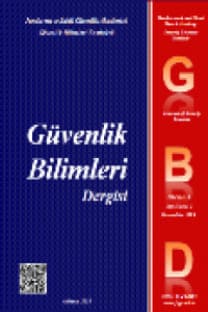RADİKALLEŞMENİN ÖLÇÜLMESİ: AŞIRICILIK ÖLÇEĞİNİN VE AŞIRICILIK ÖLÇEĞİ İLE İLİŞKİLİ ŞİDDET YANLILIĞI
Terörizm, Radikalleşme, Aşırıcılık, Aşırıcılık Ölçeği, Sosyal Psikoloji
MEASURING RADICALIZATION: ADAPTATION OF THE EXTREMISM SCALE AND PRO-VIOLENCE AND ILLEGAL ACTS IN RELATION TO EXTREMISM SCALE TO TURKISH
Terrorism, Radicalization, Extremism, Extremism Scale, Social Psychology,
___
- Abrams, D. ve Hogg, M. A. (1990). Social identity, self categorization and social influence. European Review of Social Psychology, 1(1), 195-228. doi:10.1080/14792779108401862
- Akbaş, G. (2010). Social identity and intergroup relations: The case of Alevis and Sunnis in Amasya. Yayımlanmamış yüksek lisans tezi, Orta Doğu Teknik Üniversitesi Sosyal Bilimler Enstitüsü, Ankara.
- Balaban, Ç. D. (2013). The roles of intergroup threat, social dominance orientation and right-wing authoritarianism in predicting Turks’ prejudice toward Kurds. Yayınlanmamış yüksek lisans tezi, Orta Doğu Teknik Üniversitesi Sosyal Bilimler Enstitüsü, Ankara.
- Bogardus, E. S. (1925). Measuring social distance. Journal of Applied Sociology, 9, 299-308.
- Borum, R. (2012). Radicalization into violent extremism I: A review of social science theories. Journal of Strategic Security, 4(4), 7-36. doi:10.5038/1944-0472.4.4.1
- Borum, R. (2014). Psychological vulnerabilities and propensities for involvement in violent extremism. Behavioral Sciences and Law, 32, 286-305. doi:10.1002/bsl.2110
- Cattell, R.B. (1978). The scientific use of factor analysis in behavioral and life sciences. New York: Plenum Press.
- Comrey, A.L. ve Lee H.B. (1992). A first course in factor analysis. London: Taylor and Francis.
- Corner, E. ve Gill, P. (2015). A false dichotomy? Mental illness and lone-actor terrorism. Law and Human Behavior, 39(1), 23-24. doi:10.1037/lhb0000102
- Doosje, B., Moghaddam, F. M., Kruglanski, A. W., de Wolf, A., Mann, L. ve Feddes, A. R. (2016). Terrorism, radicalization and de-radicalization. Current Opinion in Psychology, 11, 79-84. doi:10.1016/j.copsyc.2016.06.008
- Gorsuch, R.L. (1983). Factor analysis. Hillsdale NJ: Lawrence Erlbaum Associates
- Güler, M. (2013). Gruplararası temas, kaygı ve yanlılığın sosyal mesafeye etkisi: Türk ve Kürt kökenli gruplar üzerine bir çalışma. Yayınlanmamış doktora tezi, Ankara Üniversitesi Sosyal Bilimler Enstitüsü, Ankara.
- Jasko, K., LaFree, G. ve Kruglanski, A. (2017). Quest for significance and violent extremism: The case of domestic radicalization. Political Psychology, 38(5), 815-831. doi:10.1111/pops.12376
- Karaçanta, H. (2002). Üniversite öğrencilerinin sosyal baskınlık yönelimi ve başka bazı değişkenler açısından karşılaştırılması. Yayımlanmamış doktora tezi, Ankara Üniversitesi Sosyal Bilimler Enstitüsü, Ankara.
- Krieger, T. ve Meierrieks, D. (2010). Terrorism in the worlds of welfare capitalism. Journal of Conflict Resolution, 54(6), 902-939. doi: 10.1177/0022002710367885
- Kruglanski, A. W., Gelfand, M. J., Belanger, J. J., Sheveland, A., Hetiarachchi, M. ve Gunaratna, R. (2014). The psychology of radicalization and deradicalization: How significance quest impacts violent extremism. Advrances in Political Psychology, 35. doi: 10.1111/pops.12163
- Leach, C. W., van Zomeren, M., Zebel, S., Wliek, M. L. W., Pennekamp, S. F., Doosje, B. ve Ouwerkerk, J. W. (2008). Group-level self-definition and self-investment: A hierarchical (multicomponent) model in in-group identification. Journal of Personality and Social Psychology, 95(1), 144-165.
- McCauley, C. ve Moskalenko, S. (2017). Understanding political radicalization: The two-pyramids model. American Psychologist, 72(3), 205-216.
- Moghaddam, F. M. (2005). The staircase to terrorism: A psychological exploration. American Psychologist, 60, 161–169. http://dx.doi.org/10.1037/0003-066X.60.2.161
- Moghaddam, F. M. (2009). De-radicalization and the staircase from terrorism. D. Canter, (Ed.), The faces of terrorism: Multidisciplinary perspectives içinde (277-292). New Jersey: John Wiley & Sons Ltd. doi:10.1002/9780470744499.ch16
- Ozer, S. ve Bertelsen, P. (2018). Capturing violent radicalization: Developing and validating scales measuring central aspects of radicalization. Scandinavian Journal of Psychology, 59, 653-660. doi:10.1111/sjop.12484
- Pratto, F., Sidanius, J., Stallworth, L. M. ve Malle, B. F. (1994). Social dominance orientation: A personality variable predicting social and political attitudes. Journal of Personality and Social Psychology, 67, 741-763.
- Rapoport, D. (2004). The four waves of modern terrorism. A. K. Cronin ve J. M. Ludes (Ed.), Attacking terrorism: Elements of a grand strategy içinde (46-73). Washington: Georgetown University Press.
- Sageman, M. (2004). Understanding terror networks. Philadelphia: University of Pennsylvania Press
- Tajfel, H. (1970). Experiments in intergroup discrimination. Scientific American, 223(5), 96-103.
- Webber, D. ve Kruglanski, A. W. (2018). The social psychological makings of a terrorist. Current Opinions in Psychology, 19, 131-134. doi:10.1016/j.copsyc.2017.03.024
- Webber, D., Schimel, J., Martens, A., Hayes, J. ve Faucher, E. H. (2013). Using a bug-killing paradigm to understand how social validation and invalidation affect the distress of killing. Personality and Social Psychology Bulletin, 39(4), 470-481. doi:10.1177/2F0146167213477891
- ISSN: 2147-2912
- Yayın Aralığı: 2
- Başlangıç: 2012
- Yayıncı: JANDARMA VE SAHİL GÜVENLİK AKADEMİSİ
BİRLEŞİK KRALLIKTA SİBER EKONOMİK SUÇLARA YÖNELİK KOLLUK FAALİYETLERİ SORUNLARININ İNCELENMESİ
Naci AKDEMİR, Bülent SUNGUR, Bürke Uğur BAŞARANEL
STRATEJİ, ÖRGÜTLENME VE MOTİVASYONUYLA KENDİNE ÖZGÜ BİR TERÖRİST ÖRGÜT: FETÖ
Arman SERT, Cenker Korhan DEMİR, Engin AVCI
ULUSLARARASI GÜVENLİĞİN TARİHSEL GELİŞİMİ VE POST-MODERN GÜVENLİK DÖNEMİ
NATO’NUN YENİ OPERASYON ALANI: SİBER UZAY
TURİZMDE GÜVENLİK ALGISININ TÜRKİYE EKONOMİSİNE ETKİSİ
ANKLAV, EKSKLAV VE UÇ TOPRAKLAR-GÜVENLİK İLİŞKİSİ
RADİKALLEŞMENİN ÖLÇÜLMESİ: AŞIRICILIK ÖLÇEĞİNİN VE AŞIRICILIK ÖLÇEĞİ İLE İLİŞKİLİ ŞİDDET YANLILIĞI
TERÖRLE VE DİĞER SUÇLARLA MÜCADELEDE KOLLUĞUN SOSYAL MEDYA KULLANIMININ DEĞERLENDİRİLMESİ
SU VE SU GÜVENLİĞİ KONUSUNDA İKLİM DEĞİŞİKLİĞİNE UYUM TABANLI STRATEJİLER: DAKKA VE ANKARA ÖRNEĞİ
